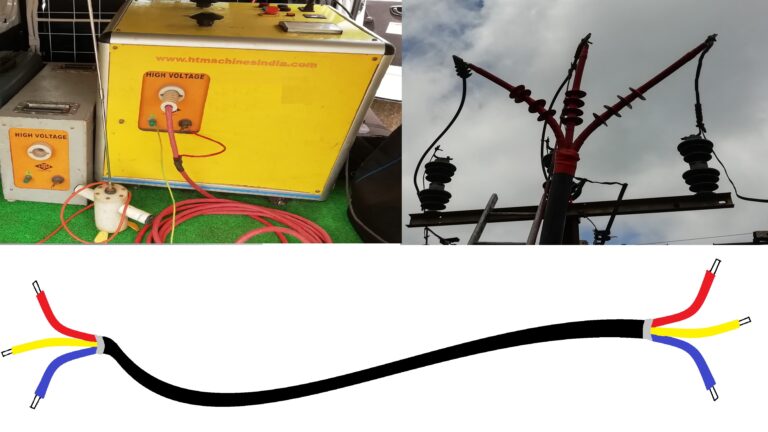What the Hipot test?
A Hipot test means a Hipotential test. Usually, a Hipot testing is done to check whether an Electrical equipment such as power cable is healthy or not.

The components of the Hipot Test kit
1. An Autotransformer &
2. A Test Transformer are its major components
Also, there are some other necessary components installed inside the test kit.
Hipot Test Procedure

First of all, the cable which is to be tested is isolated completely from both ends. And all three phases of the cable are discharged using earth rods. This makes cable free of any possible residual charges and safe to work.
220V AC power input is given to the Autotransformer through a control box, and autotransformer output is used to adjust the input voltage to the test transformer’s primary windings. The test transformer is used to raise the voltage to the required test level.
As in the diagram, in the case of AC Hipot testing, secondary winding terminal of the test transformer is connected to the phase conductor of the cable. In the case of DC Hipot testing, the silicon rectifying diode is connected in series with the secondary of the test transformer. And secondary terminal of the test transformer is connected to the phase conductor of the cable through this diode. Another terminal of the secondary of the test transformer is connected to the ground along with the cable armor.
With the connections as shown in the diagram, insulation between the Phase conductor and the ground is tested. When the cable is in service and charged condition, the armor of the cable is connected to the ground, and the armor is at zero potential. Hence, with this connection insulation between phase conductor and armor is also tested. This is how the input voltage of 220 volts is raised to the required test voltage which can be 6kv to 60kv, and the Hipot test is carried out. Depending upon the insulation and voltage level of the object to be tested the test voltage is raised.
The same procedure is repeated for the other two phases of the cable. This way we could check the healthiness of insulation between phase and earth. To check insulation healthiness between two phases, high voltage lead is connected to one phase and other lead is connected to the other phase and ground.
How the Hipot test voltage level is decided?
Hipot test voltage level is set as per standards.
1. AC Hipot Test Voltage

For example, let’s consider for AC Hipot testing of a cable, the voltage level is raised to 33kV which is the RMS value of the line voltage. But instantaneously insulation experiences the peak value of 33kV = 1.414 x 33kv = 46.67kv. In short in AC Hipot testing, when the test voltage level is raised to 33kV, the insulation experience 46.67kV.
Hence in AC Hipot test, insulation experiences a higher voltage than the set test voltage, due to the sinusoidal nature of AC voltage.
2. DC Hipot Test Voltage

In a DC Hipot the test voltage we set using the kit and voltage level experienced by the insulation to be tested is the same.
DC Hipot Test Voltage = 1.414xAC Hipot Test Voltage
DC Hipot Test Voltage = 1.414(2xVL + 1000) Volts
Also, DC Hipot Test Voltage = 65%(3.4xVL + 1700) volts
It is recommended to refer to the standards before conducting Hipot tests.
eg. IEEE 95, IEC, ANSI/EASA AR100